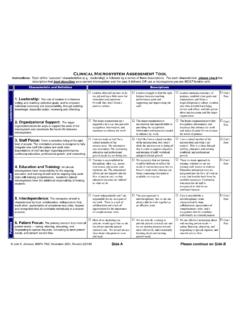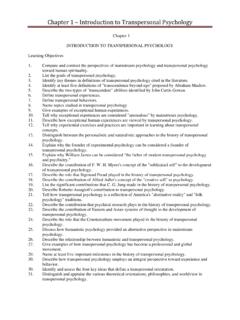Transcription of Microsystems in Health Care
1 Joint Commissionon Quality and SafetyJournalAs stated at the outset of the Microsystems inHealth Care series, the Health system is com-posed of a few basic parts front-line clinicalmicrosystems, overarching macrosystems, and patientsubpopulations needing (Part 1) Microsystems think-ing makes several organizational assumptions:1. Bigger systems (macrosystems) are made of small-er systems2. These smaller systems ( Microsystems ) producequality, safety, and cost outcomes at the front line of care3. Ultimately the outcomes of the macrosystem can beno better than the Microsystems of which it is composed1In addition, the microsystem is the logical locus forlinkage between vision and delivery and therefore canand should act as the agent for change within amacrosystem. If strategically driven and if the perfor-mance of each individual microsystem is optimized, themicrosystems within a macrosystem can facilitate sys-tematic transformation at all levels of the system.
2 This article describes how the microsystem, as an agentfor change, plays a critical and essential role in developingand deploying the macrosystem s strategic plan. Strategic Planning and MicrosystemsThinkingThe critical need for an organization to have a strategicplan is well established. A well-designed strategic plansupports the organization s mission, vision, and should be the result of an organization s careful eval-uation of its position in the marketplace based on theparameters of service, quality, access, scope, innova-tion, and organization cannot be452 September 2003 Volume 29 Number 9 Background:The microsystem, as agent for change,plays a critical and essential role in developing anddeploying the macrosystem s strategic plan. Strategic planning and microsystem thinking:To effec-tively deploy a strategic plan, the organization must alignthe plan s goals and objectives across all levels and to allfunctional units. The concepts of microsystem thinkingwere the foundation for the journey on which OverlookHospital/Atlantic Health System (Summit, NJ) embarkedin 1996.
3 Six stages can be identified in the develop-ment of the relationship between macrosystems andmicrosystems. Five critical themes - trust making, miti-gation of constraints and barriers among departmentsand units, creation of a common vocabulary, raising ofmicrosystem awareness, and facilitation of reciprocalrelationships are associated with these stages. Notes from a microsystem journey:The emergencydepartment (ED) experienced Stage 1 The Emergenceof a Self-Aware Microsystem as it created cultural andbehavioral change, which included the actualization ofstaff-generated ideas and an ongoing theme of trustmaking. In Stage 3 Unlike Microsystems (DifferentUnits) Learn to Collaborate the ED s microsystemsapproach spread to other units in the addressed x-ray turnaround times,admission cycle times, and safety initiatives. Summary and conclusions:The microsystem thesmall, functional, front-line units is where the strate-gic plans become in Health Care:Part 7.
4 The Microsystem as a Platform for MergingStrategic Planning and Operations Microsystems in Health CareLinda K. Kosnik, , A. Espinosa, to everyone and must identify the goals andobjectives that best position it in the marketplacetoward achieving strategic plan identifiesthe organization s chosen approach to achieving thesegoals and objectives. If a strategic plan is to be effectively deployed, theorganization must align the plan s goals and objectivesacross all levels and to all functional units. Even thebest-developed strategy can become diluted as it trav-els through the organization as the staff members indifferent units who must execute the plan interpret iton the basis of their perspectives of the goals employees with the company sstrategy is the most important and most challengingtask facing any and innovative solu-tions are needed to diffuse the organizational strategicplan. Historically, organizations have not used struc-tured approaches to translate high-level strategy state-ments into specific have clinical and business aims, policies-in-use, linked processes, and a shared information envi-ronment, and they produce services and care, which canbe measured as performance outcomes.
5 These systemsevolve over time and are often embedded in larger sys-tems/organizations. As any living, adaptive system, themicrosystem must (1) do the work, (2) meet staff needs,and (3) maintain itself as a clinical Microsystems have similar optimal charac-teristics: leadership, culture, macro-organizational sup-port, patient focus, staff focus, interdependence of careteam, information and information technology, processimprovement, and performance microsys-tems framework provides practical steps for designingor redesigning Microsystems to perform optimally inalignment with the strategic plan. As explained in a pre-vious article in the Microsystems in Health Care series,the starting place for the design or redesign of clinicalmicrosystems is always to evaluate the four P s: thepatient subpopulations that are served by the microsys-tem, the people who work together in the microsystem,the processes the microsystem uses to provide services,and the patterns that characterize the microsystem concepts of Microsystems thinking have been thefoundation for the journey on which we in the emer-gency department (ED) of Overlook Hospital/AtlanticHealth System (Summit, NJ) embarked in 1996.
6 In the course of this experience, we have identified sixstages in the microsystem journey. Each stage is richerthan the previous one in complexity and allows for morecollaboration (see Sidebar 1, above).In the following section we discuss five themes inthe context of the six microsystem stages and describesome of the approaches and tools we have used anddeveloped. In the work of developing and deploying strategicplans, macrosystems and Microsystems are well servedto maintain feed-forward and feed-back loops so newinformation can flow into future macrosystem planning,which can then be deployed at the microsystem feed-back loops represent the movement ofinformation in multiple directions between the microsys-tems and macrosystems, thereby allowing for continu-ous assessment and reassessment. We have developed amodel for feed-forward and feed-back loops in the workof strategic planning and the work of the microsystem(Figure 1, page 454).
7 Joint Commissionon Quality and SafetyJournalSeptember 2003 Volume 29 Number 9 Sidebar 1. Six Stages and Five ThemesSix stages can be identified in the development of therelationship between macrosystems and Microsystems :1. A self-aware microsystem (m1)2. A group of like Microsystems (m1+ m1+ m1)3. A group of unlike Microsystems (m1+m2+m3) 4. A group of Microsystems in relationship with amacrosystem (m1+m2+ +M1)5. A group of like macrosystems (M1+ M1+ )6. A group of unlike macrosystems (M1+ M2+ )Five critical themes that play a role in the stages canbe identified: 1. Trust making2. Mitigation of constraints and barriers amongdepartments and units3. Creation of a common vocabulary4. Raising of Microsystems awareness5. Facilitation of reciprocal relationships454 September 2003 Volume 29 Number 9 Notes from a Microsystem JourneyStage 1: The Emergence of a Self-AwareMicrosystem (m1); Critical Theme: Trust MakingOur work philosophy had developed with a strong empha-sis on understanding and improving the care processes tomaximize patient satisfaction.
8 We emphasized the role ofsenior leadership in the ED s success by making the goal ofimproving ED patient satisfaction part of the organization sstrategic plan. We used process improvement approachessuch as a patient satisfaction summit and an ED patientsatisfaction lab to create cultural and behavioral change(see Sidebar 2, page 455).Development of Awareness of Ourselves as a Self-Aware Microsystem (m1).We had often thoughtof the ED as representing a sort of hospital in miniature and therefore immediately related to the principles ofmicrosystems thinking at the time of our first imprinting at an Institute for Healthcare Improvement (IHI) Forum in1999, when the concept of Microsystems in Health carewas recognized that we had intuitivelybegun to manage the ED as a microsystem. We saw thatenterprisewide strategic plans could be operationalized ona unit level in our ED hospital-in-miniature by translatingwhat we, in retrospect, would term macrosystemto whatwe would now term microsystemlevel.
9 For example, patient satis-faction is a strategic goal ofboth the hospital and the hos-pital system. In translating itto the ED, we looked for high-leverage changes that couldactualize the overall strategicgoal, such as the develop-ment of a fast-track system,bedside registration, support-services cycle times, andopportunities for structuraland environmental improve-ments. A cultural revolutionto support change was drivenby addressing workplacequality issues and a rewardand recognition program. A clinical improvementinitiative started off withimprovements in pain management that contributed topatient satisfaction. Many of the process improvementswere targeted at not only reducing waits and delays butalso improving the underlying clinical processes thatdrove them. The bulk of these high-leverage changesemerged from the patient satisfaction summits. The ED s goals were consistent with the organization sstrategic goals.
10 As a result, we were increasingly able to secure administrative support for our initiatives. The ED had undergone the cultural change of Microsystems thinking it had become a self-aware microsystem. Life as a Self-Aware createdmonthly microsystem meetings, which are part retreat andpart working group. They are interdisciplinary as well asinterdepartmental, with representation from various unitsin the hospital, depending on the agenda. Some of thesemicrosytems appear to have become self-aware in thecourse of these meetings. The microsystem s customers,such as patients, families, and attending physicians, mayalso attend these meetings, at which practical and innova-tive tools such as storytelling, root cause analysis (RCA;for near-miss events and patient and staff complaints), appreciative inquiry (use of RCA for positive outliers),and simulation are deployed. Each meeting lasts four tofive hours, but a meeting saves an estimated two to threeJoint Commissionon Quality and SafetyJournalFigure this model for feed-forward and feed-back loops in the work of strategicplanning and the work of the microsystem, feed-back loops represent the movement ofinformation in multiple directions between the Microsystems and macrosystems,thereby allowing for continuous assessment and Microsystem/Macrosystem Strategic Plan Feed-Back System455times that amount of time because many other meetingscan be folded into the multipurpose microsystem meeting.








